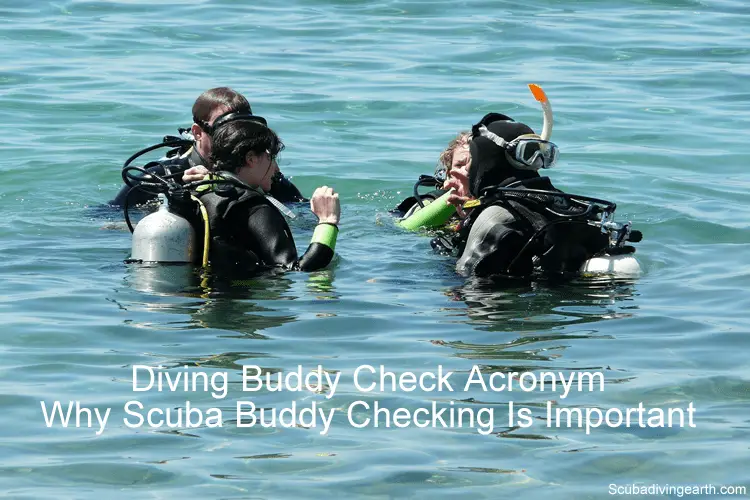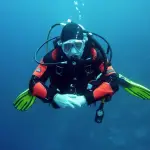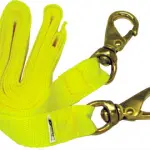
Why scuba buddy checking is important and how to remember what to check using an acronym or mnemonic
The dive buddy check just before your dive is an important safety check for every scuba diver. A buddy check an often forgotten check, but is made easy using a diving buddy check acronym or mnemonic like the ABC or BWRAF system to make diving safe.
This is why it’s important to remember your buddy check using an acronym. Many divers use a diving buddy check acronym or mnemonic to remember how to carry out a scuba dive buddy check before a dive. Acronyms or mnemonics include the ‘ABC’ BSAC buddy check and the ‘BWRAF’ PADI dive check and confirm both your and your buddy’s kit is in good working order.
A scuba dive buddy check is for your safety and your buddy’s safety and helps to familiarise you both with each others scuba kit and confirms your air is switch on.
The best way to do more diving is to book yourself on a scuba diving liveaboard. You can check the latest and best deals on liveaboards using the following window:
What is a scuba dive buddy check?
A scuba dive buddy check is a check performed on the surface BEFORE the dive commences. This is performed on a dive boat or on the shore, but should be done before you enter the water.
If you’re doing a shore dive you can walk into the water first before you carry out your scuba dive buddy check. But make sure you do the check before submerging.
More Reading: How do I get a dive buddy? (5 easy ways to find a dive buddy)
Why scuba dive buddy checks are not performed
Most divers don’t perform a buddy safety check, as they’ve become complacent about the importance of this check. It only takes one small error that’s missed as a result of not performing a buddy check that could lead to problems on a dive.
It’s far easier to fix a problem found on a buddy check than it is to deal with underwater. The number of times I’m on dive boats when I’m seeing that divers just don’t do buddy checks at all.
The buddy that I get paired up with is usually surprised by my insisting on doing the buddy check. But they also usually appreciate the reminder of how important buddy checking is.
I also find that I get positive comments from the dive guide on the boat too. But it should be part of the dive plan and brief beforehand to encourage dive buddy checks.
Pro diver tip: It’s only after you save someone from an air supply problem that you really understand the need for buddy checks. I’ve experienced two life-threatening situations underwater involving diving equipment failure. This type of incident tends to focus your mind.
I encourage you to always perform a scuba diving buddy check each time you dive. Please perform a buddy check no matter how deep your dive and no matter who your dive buddy is. If your buddy refuses to do the buddy check with you, I suggest you refuse to dive with them until they do.

Why scuba dive buddy checks are important
Scuba dive buddy checks are important for the following reasons:
- A buddy check confirms own your scuba equipment is in good working order.
- You are also confirming your buddy’s diving equipment is in good working order.
- The buddy safety check also confirms you both have your air switched on.
- The scuba diving buddy check also helps you both familiarise each other with your buddy’s dive kit. This includes knowing where your buddy’s alternative air sources is located; Is it in working order; plus how easy are they to get to?
- The buddy check is for your piece of mind and for your buddy’s piece of mind.
Diving buddy check acronym or mnemonic
Many scuba divers use a diving buddy check acronym or mnemonic to remember the scuba dive buddy check sequence. This is especially true for beginner scuba divers whilst they are learning to dive.
If you’ve forgotten how to do a scuba dive buddy safety check, here are a couple of acronyms or mnemonics to help you remember.
Use the ABC pre-dive check acronym for a buddy check
Using the ABC pre-dive check acronym will help you to remember what to check before the dive.
The ABC pre-dive check acronym is the BSAC buddy check system, the Scuba Diving International (SDI) system and Technical Diver International (TDI) system.
The ABC pre-dive check acronym:
‘A’ is for air – check and demonstrate this to your buddy first and visa versa
- Check that your air is okay and switch on.
- Check that your air supply is working properly.
- When you test your air check your air gauge for any fluctuations. If your needle drops when you inhale, this indicates that the valve is either closed or only partially opened. Or that your air is turned off. Show your buddy the gauge to confirm it’s okay. Confirm out-loud what you are demonstrating.
- Does your air ‘taste’ okay. Openly confirm this out-loud.
- Carry out the same tests on your main regulator and on your alternative air supply (your octopus).
- The check on your alternative air supply shows your buddy where it is on your kit.
- Confirm to your dive buddy you are happy for them to take it in an emergency.
- Demonstrate how to detach it.
‘B’ is for buoyancy – check and demonstrate this next
- Check that your ‘air-in’ or direct feeds all work on your buoyancy control device (BCD) or stab jacket. (Check the same on your drysuit if it’s a drysuit dive). Press your auto-inflator button to confirm it works by putting a small amount of air in to your BCD or drysuit.
- Make sure the air feeds are connected properly. (This includes your drysuit feeds where applicable).
- Confirm to your buddy where all the dumps valves are for an emergency. (This applies for your BCD and for your drysuit if applicable)
- For drysuit diving confirm which buoyancy method you’ll be using, i.e. either your BCD (Stab jacket) or your drysuit or a bit of both.
More Reading: Does a dry suit keep you dry (What are the exceptions & do you get wet)
‘C’ is for clips and releases – check and demonstrate this last
- Run through all your clips and releases.
- Do this for your buoyancy control device (Stab jacket) and for your weight belt release.
- Explain if your weights are built-in to your BCD, and how to remove them in an emergency.
Once you’ve demonstrated your dive equipment to your buddy, get them to show you their equipment. You should each know how the other’s equipment works and where everything is.
We all think that things won’t go wrong. But things can and do go wrong with scuba diving. Make sure you are prepared.
The PADI BWRAF acronym for diver buddy checks
The BWRAF acronym is the buddy check recommended by PADI. The PADI dive check more commonly known as the buddy check is also recommended as the last thing you do before entering the water for your dive.
PADI recommend it as a good procedure to use for reviewing your dive plan plus knowing your signals to be used on your dive.
The PADI 5 step pre-dive safety check BWRAF acronym
Step 1: B is for BCD or Buoyancy control device
Use the BWRAF acronym you’ll be checking your BCD first.
For this first step, your buddy will test their inflator and deflator valves and demonstrate this to you. This is then reversed where you test your inflator and deflator valves and demonstrate your BCD to your buddy.
If the dive is a drysuit dive, this first check should also check the inflator and deflator valves on each of your drysuits too.
Step 2: W-Weights and weight-belt
The second step of the BWRAF pre-dive safety check is to check your buddy’s weights and weight belt and for them to check yours. Make sure the safety check includes looking at the quick release. This ensures that it’s fully closed so neither of your weight belts come loose on the dive.
If you or your buddy is using a BCD with integrated weights, make sure you know how to release the weights in an emergency. In both cases both must make sure the weight pouches are properly secured.
Step 3: R-Releases and clips
This part of the pre-dive safety check is to check all of releases on your equipment. This includes the releases on your BCD, which should be checked to make sure they are all secured.
The cummerbund, shoulder straps and clips should be flat and properly tightened and non should be twisted. Check that any equipment which is hanging from yours and your buddy’s BCD is secure.
Step 4: A-Air supply for main regulator and alternative air supply (octopus)
This is the pre-dive safety check to make sure your air is on and isn’t contaminated.
Have your buddy check that your air tank valve is fully open and you check your buddy’s too. Never over-open the tank valve and I always recommend to open it fully and turn it back a quarter turn.
When you check your buddy’s air have them take a few full breaths from the regulator. As they do so watch their air pressure gauge. The gauge’s needle should remain steady and shouldn’t drop. If it does, then something could be wrong. This is likely to be something as simple as your air is not turned on. The same check should be carried out for your buddy’s alternate air supply or octopus.
Once you’ve checked your buddy’s air supply on their main regulator and their alternative air supply, switch and get them to check yours with your breathing from your own regulators.
Pro diver tip: It’s a myth that turning the air valve back a quarter turn is responsible for some diver deaths. This small amount of turn has no affect on the airflow and is something I’ve done for over 30 years of scuba diving.
Step 5: F-Final pre-dive safety check
The final step in the pre-dive safety check is to do a final overall check. This final check is to ensure all your gear is present and correct and looks okay. Finally make sure you have your fins and mask.
Diver fatalities and being safe whilst scuba diving
I recently wrote an article about whether scuba diving is more dangerous than skydiving. It turns out that you are three times more likely to die whilst scuba diving than you are skydiving. I’m not sure if you’re surprised, but I certainly was.
1 diver in 34,400 scuba dives involves a fatality, whereas the odds for skydiving are 1 in 101,083 instead.
I don’t tell you these statistics to put your off scuba diving or from learning to scuba dive, but I tell you them to encourage you to be safe. A scuba dive buddy check or pre-dive safety check takes only a few minutes to perform, and it could save yours or your buddy’s life.
I hope you enjoyed this article about diving buddy check acronym
I’d love to hear from you. Tell us about your adventures of diving and snorkeling, in the comments below. Please also share your photos. Either from your underwater cameras or videos from your waterproof gopro’s!
If this article hasn’t answered all of your questions. If you have more questions either about snorkeling or scuba diving (or specifically scuba about diving buddy check acronym), please comment below with your questions.
There will also be many more articles about scuba diving (and on snorkeling) for you to read and learn about this fabulous sport.
Have fun and be safe!





